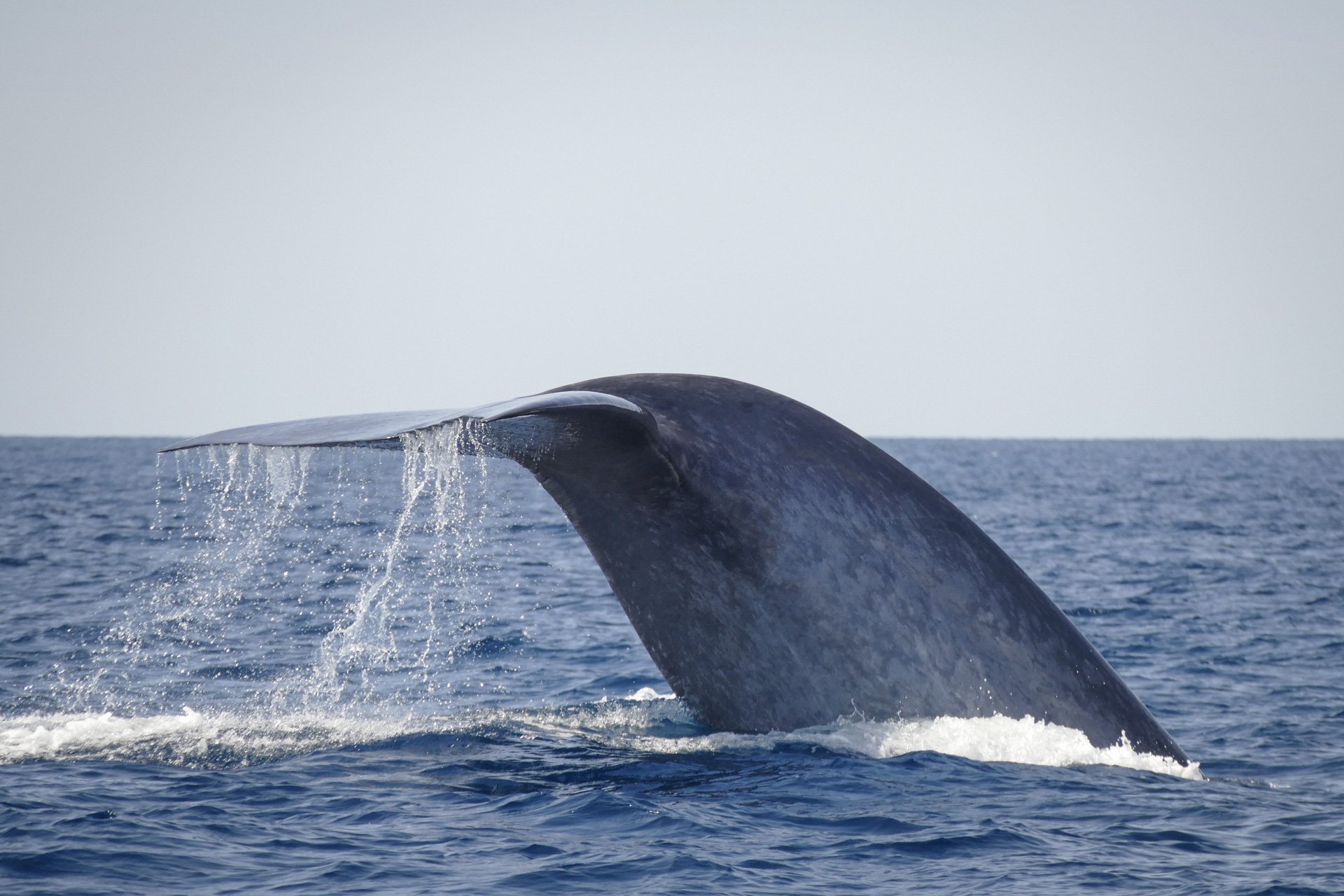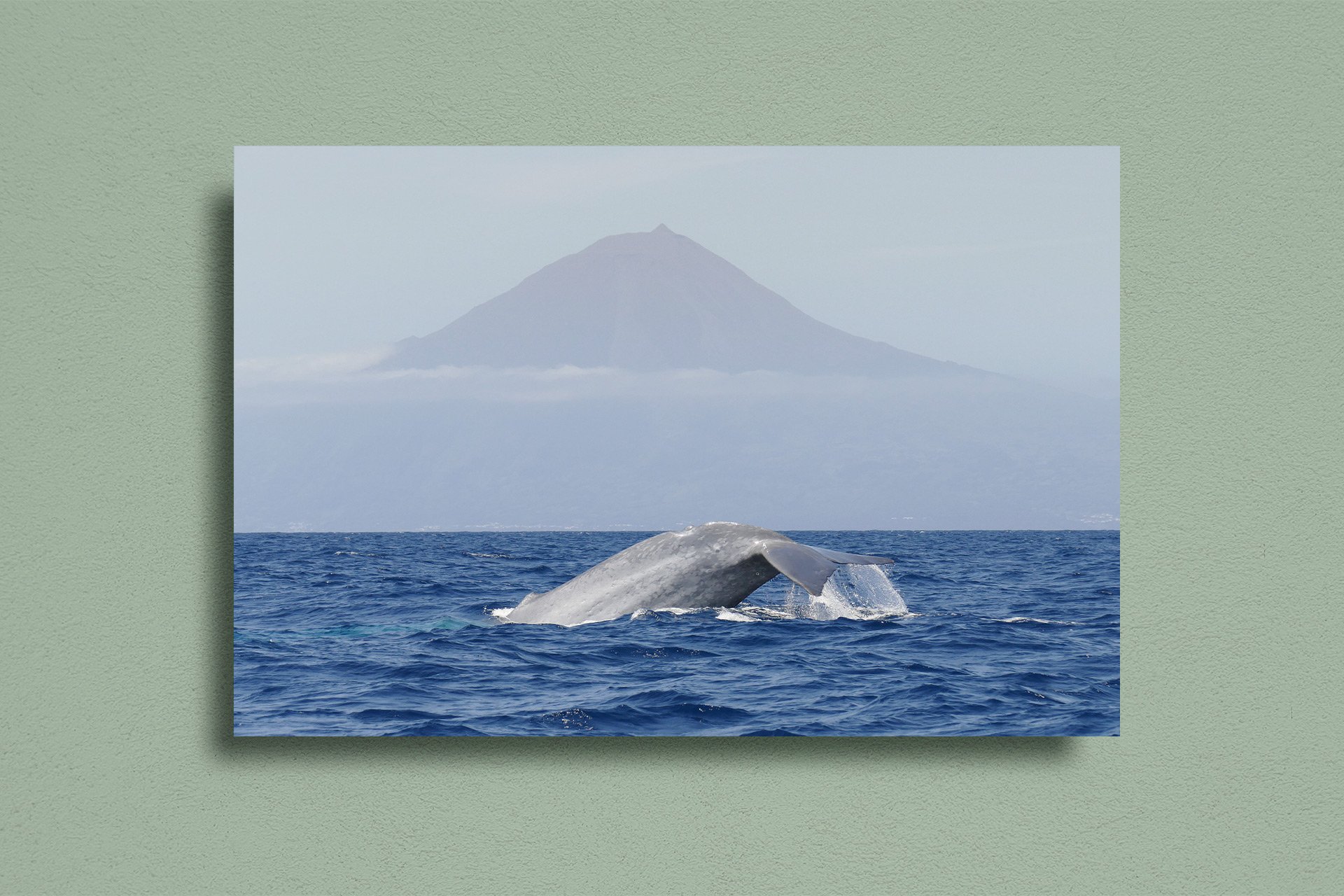BLAUWALE
Die grössten Tiere aller Zeiten. Gute Chancen auf eine Begegnung hat man vor den Azoren, in Québec und Mexiko.
Foto: Oliver Dirr / Whaletrips
REVIEW: Blauwale
Blauwale sind die größten und schwersten Tiere, die je auf dieser Welt gelebt haben. Inklusive aller bekannter Dinosaurier.
Eine der besten Sachen an Walen ist ohne Frage ihre pure, schiere, unfassbare Größe, mit der sie völlig unvermittelt aus der Tiefe auftauchen. In dieser Hinsicht der beste Wal von allen: der Blauwal.
Der Blauwal ist das größte Tier, das jemals auf der Erde gelebt hat. Wirklich: jemals, inklusive aller Dinosaurier. Er wiegt sogar mehr als doppelt so viel wie die größten Saurier, bis zu 190 Tonnen. Ich habe das durchgerechnet, 190 Tonnen, das ist ungefähr so viel, wie eine leere Boeing 757, zehn Mittelklasse-Autos, zwanzig Elefanten und einhundert Menschen – zusammen.
Im Schnitt erreicht ein Blauwal eine Länge von 26 Metern, der längste bislang gemessene kam sogar auf 33 Meter, das ist ungefähr so lang, wie drei großzügig hintereinander geparkte Schulbusse. Ein normales Zodiac-Boot, mit dem man auf so einer Whale-Watching-Tour oft unterwegs ist, kommt im Vergleich auf gerade mal 4 bis 8 Meter.
Allein die Fluke eines Blauwals ist ungefähr so groß wie so ein Zodiac. Schön zu wissen, dass sich Blauwale überhaupt nicht für Zodiacs und Menschen interessieren. Normalerweise schwimmen sie einfach gemächlich und entspannt mit einem Ruhepuls von ca. 4 bis 6 Herzschlägen pro Minute vor sich hin.
„Das Herz eines Blauwals ist so groß und schwer wie ein Kleinwagen, in seiner Aorta könnte ein kleines Kind schwimmen, und auf seiner Zunge, die schon allein so schwer ist wie ein kompletter Elefant (!), hätte eine halbe Schulklasse Platz.“
Im Grunde haben Blauwale nur ein einziges Interesse: Krill. Den ganzen Tag lang geht es um nichts anderes als Krill. Und auch hier: alles mit der Ruhe. Blauwale stellen ihrer Beute nach, indem sie mit weit geöffnetem Maul in Krill- oder Fischschwärme (meist von unten) hineinstoßen und mit ihren riesigen Barten alles Essbare abschöpfen. So kommen sie mit überschaubarem Aufwand auf 5 bis 8 Tonnen Nahrung pro Tag. Rekord.
Weitere Super-Rekorde: Das Herz eines Blauwals ist so groß und schwer wie ein Kleinwagen, in seiner Aorta könnte ein kleines Kind schwimmen, und auf seiner Zunge, die schon allein so schwer ist wie ein kompletter Elefant (!), hätte eine halbe Schulklasse Platz. Wie gesagt: Blauwale sind groß.
Drei hintereinander geparkte Schulbusse: Das ist so ungefähr die Länge, die ein ausgewachsener Blauwal erreichen kann.
Und Blauwale sind nicht nur die größten und schwersten Tiere der Welt, sie gehören auch zu den lautesten. Unter Wasser kann ein Blauwal Lautstärken von bis zu 180 Dezibel produzieren. Bei einem Motörhead-Konzert kam man in den 90ern gerade mal auf 120, den Rekord halten Manowar mit 139 Dezibel – das ist also alles nichts gegen den Blauwal. Das einzige Tier, das noch lauter werden kann: der Pottwal – hier wurden schon Klicks mit 236 Dezibel gemessen!
Die niederfrequenten Töne der Blauwale sind so laut, dass sie nach Meinung mancher Experten sogar von Pol zu Pol reichen könnten, also die vollen 20.000 Kilometer, wenn die zahlreichen Hindernisse unterwegs sie nicht aufhalten würden. Aber auch so können Blauwale wahrscheinlich über Hunderte und Tausende Kilometer hinweg miteinander kommunizieren, sofern der zunehmende menschengemachte Lärm im Meer das zulässt.
Und das wiederum ist sehr praktisch, denn erstens sind Blauwale Einzelgänger und zweitens gibt es leider kaum noch welche. Aufgrund des massiven Walfangs der letzten Jahrhunderte sind Blauwale extrem bedroht: Weltweit gibt es nur noch wenige Tausend. Trotzdem hat man immerhin an ein paar Orten dieser Welt wieder ganz gute Chancen, ihnen zu begegnen.
Foto: Oliver Dirr / Whaletrips
GRÖSSE
Blauwale werden 24 bis 33 Meter lang, Weibchen sind meist größer als Männchen. Gewicht: bis zu 190 Tonnen.
FARBE
Anthrazit, schiefergrau, blaugrau, die Farben variieren. Am besten erkennbar an den grauen bis weißen Sprenkeln.
FORM
Riesiger, langer Körper mit breitem, flachem, U-förmigem Kopf, der bis zu einem Viertel der Länge einnehmen kann.
BLAS
Sehr hoher, schmaler Blas, kann 8 bis 12 Meter und höher sein, ist von sehr weit zu erkennen.
FINNE
Sehr weit hinten, sehr klein, manchmal spitz, manchmal sichelförmig, manchmal auch nur ein kleiner Höcker.
FLUKE
Sehr breite Fluke, ca. ein Fünftel der Körperlänge. Hinterkante mit spitzen Enden, Von der Seite massiver Schwanzstil.
VERHALTEN
Uninteressiert an Booten, schwimmt langsam an der Oberfläche. Hebt beim Abtauchen sehr selten die Fluke.
TAUCHGÄNGE
Blauwale tauchen meist für ca. 10 bis 30 Minuten.
BESTAND
Weltweit gibt es wahrscheinlich noch zwischen 8.000 und 12.000 Tiere.
Foto: Oliver Dirr / Whaletrips
CHECKLISTE: Blauwale
Blauwale sind so lang, dass man Blas und Finne niemals gleichzeitig über Wasser sieht. Beim Abtauchen hebt nur jede fünfte Blauwal die Fluke, manche tun es nie.
Blauwale sind meistens allein unterwegs, manchmal zu zweit, selten in größerer Anzahl. Normalerweise schwimmen sie gemächlich an der Oberfläche entlang und sind Booten gegenüber ziemlich gleichgültig. Die normale Geschwindigkeit liegt zwischen 5 und 15km/h, beim Fressen noch etwas weniger, auf der Flucht können sie dagegen bis zu 30 km/h erreichen.
Meist tauchen Blauwale in eher flachem Winkel auf, sobald der Kopf an der Oberfläche ist, sieht und hört man den riesigen Blas, dann taucht der Kopf schon wieder ab und ein großer Teil des enorm langen Rückens wird sichtbar. Auf diese Weise geht es für mehrere Atemzüge auf und ab, ohne dass man überhaupt mal die Finne sieht, die viel weiter hinten auf dem Rücken sitzt.
„Höher als ein mehrstöckiges Wohnhaus: Der Blas eines Blauwals ist auch aus großer Entfernung sehr gut zu erkennen.“
Erst wenn der Blauwal erneut für längere Zeit abtaucht – erkennbar an einem lauteren letzten Blas und einer deutlichen Krümmung des Rückens – wird die Finne an der Oberfläche sichtbar. Bei tieferen Tauchgängen kann man manchmal auch die Fluke sehen, meist bleibt sie aber unter Wasser, Blauwale tauchen in recht flachem Winkel auf und ab.
Ohnehin zeigt nur jeder fünfte Blauwal überhaupt mal die Fluke, manche tun es sogar nie. Auch ansonsten sind Blauwale nicht sonderlich aktiv an der Oberfläche: Sie springen selten, spähen selten und schlagen auch nur selten mit Fluke oder Flippern auf das Wasser. Sie hieven einfach nur in aller Seelenruhe ihren gigantischen Körper durch das Wasser. Beeindruckend genug.
Foto: Oliver Dirr / Whaletrips
WO UND WANN: Blauwale
Da Blauwale extrem selten sind, gibt es nicht allzu viele Orte, an denen man ihnen begegnen kann. Andererseits sind ihre jährlichen Wanderrouten gut bekannt.
Blauwale wandern meist zwischen tropischen und polaren Gewässern hin und her, theoretisch kann man sie in allen Weltmeeren antreffen. Im Sommer sind sie in den kühleren Gewässern auf Nahrungssuche, im Winter bringen sie in den wärmeren Gewässern ihre Jungen zur Welt.
Im westlichen Atlantik findet man Blauwale in den Gewässern von Grönland über Québec bis nach Neuengland hinunter, die besten Chancen an der nordamerikanischen Ostküste hat man im St.-Lorenz-Golf von Quebec, wo eine Population von über 400 Blauwalen lebt.
Im östlichen Atlantik findet man Blauwale vor allem vor den Azoren (Frühjahr) und Island (Frühjahr und Sommer), wenn sie auf dem Weg nach Norden sind und nahe an der Küste einen Zwischenstopp einlegen, um zu jagen. Trotzdem braucht man etwas Glück: Im gesamten Nordatlantik leben nur noch wenige Hundert Tiere.
Der ideale Begleiter für eure nächste Walreise: Im Shop findet ihr unsere TRAVEL NOTES in fünf tollen Farben – mit den wichtigsten Wal-Infos für unterwegs und ganz viel Platz für eigene Notizen, Beobachtungen und Erinnerungen. Jetzt bestellen!
Im Nordpazifik gibt es zwischen Alaska und Kalifornien wahrscheinlich bis zu 3.000 Blauwale – die besten Chancen an der nordamerikanischen Westküste hat man vor Kalifornien und der mexikanischen Baja California.
Auf der Südhalbkugel sind Blauwale überall bis hinunter zur Antarktis zu finden. Die besten Chancen hat man vor Chile, auf Sri Lanka und den Malediven, die Populationen im Nordindischen Ozean sind sehr wahrscheinlich ortstreu. Auch im Süden Australiens werden sie oft gesichtet.
Da Blauwale sich vor allem von Krill ernähren und Krill tagsüber gewöhnlich eher in der Tiefe ist und erst bei Sonnenuntergang aufsteigt, sind Blauwale oft nachmittags, abends und nachts aktiv. Man sollte also nicht unbedingt die erste Tour des Tages mitmachen.
Noch mehr Wale
〰️
Noch mehr Wale 〰️
Whaletrips Shop
Über den Wal, die Welt und das Staunen
Das Beste aus zehn Jahren Walfahrt. Bei uns im Whaletrips-Shop auch mit persönlicher Widmung nach Wunsch!
Whaletrips Shop
Unsere Wale als Karten und Sticker
Farbenfroh, schwarz-weiß illustriert, zum Aufkleben: Unsere Wale gibt es auch als Sticker- und Grußkarten-Set!
Whaletrips Shop
Notizhefte: Unsere Notes und Travel Notes
Die idealen Begleiter für eure nächste Walfahrt: in fünf tollen Farben im Whaletrips-Shop erhältlich!
Whaletrips Shop
Elegante Fine Art Prints für Zuhause
Unsere beliebtesten Motive gibt es auch als edle Fine Art Prints für Zuhause. Verschönern jede Wand!











